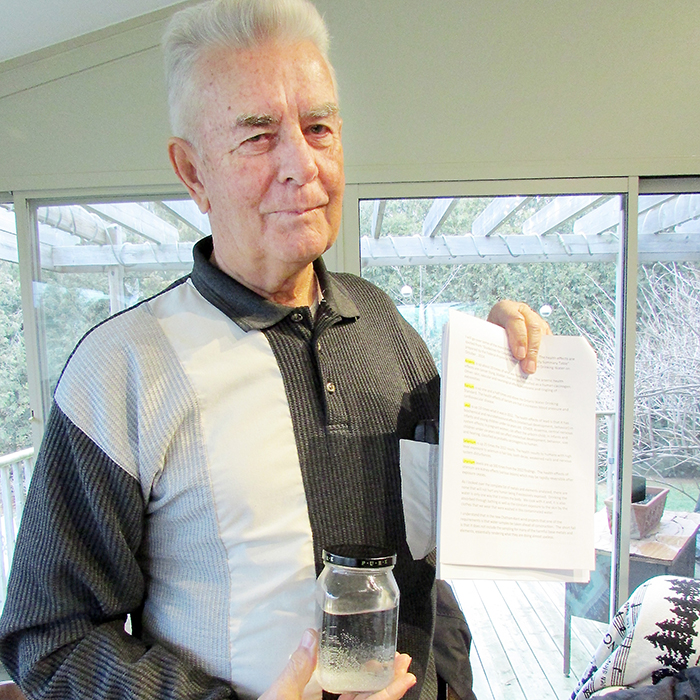
Dover farm owner Pete Hensel wants someone to care that his well water, good for close to 70 years, now has concerning levels of heavy metals.
At a press conference at his farm in the former Dover Twp., Hensel said he had his well water tested back in 2012, at a cost of $400, before wind turbine construction began around his property. He held up a jar of his water, which looked clear.
“Here is a sample of what my drinking water looks like now. To the naked eye, it is the same as it looked back in 2012 before anything in my general area changed,” he said. “Almost all of the elements that were tested are higher in my 2016 analysis than they were in the 2012 analysis.”
Those elements include arsenic, barium, lead, selenium and uranium. Some of the numbers he said, are not exact because it couldn’t be determined if the readings were due to the elements being dissolved in the water or if they were in the microparticles of Kettle Point black shale that the water is carrying.
“These microparticles aren’t visible to the eye and I drink, bathe, wash clothes and cook with the water, so does it really make any difference?” Hensel questioned.
Arsenic levels are up 10 times the level of 2012, barium is one and half times above the acceptable Ontario Drinking Water Standard, lead is up 13 times, selenium up 25 times and most concerning, uranium levels were up 500 times the 2012 tested levels.
“As I looked over the complete list of metals and elements analyzed, there are none that will not hurt any human being if excessively exposed,” Hensel said. “It’s the long-term health effects over 20 to 25 years. Not me, I’m going to die anyway, but what about the young people?”
The Dover farmer said he has been asked by all levels of government why he thinks the wind turbines are the cause of the problems with his well.
“I feel through the process of elimination that it could not be anything else. I have lived here for in excess of 75 years and I think of changes that have taken place and what could have caused the Kettle Point shale and minerals it contains from approximately 70 feet underground to start appearing in my drinking water,” Hensel said.
No explosions, earthquakes, bombings or other major happenings have occurred, he noted, even when four holes were drilled for oil wells about 35 years ago near his property. He noted those holes were drilled, not driven into the ground like the supports for the wind turbines were.
“That leaves only the vibrations caused by driving 28 steel I-beams down to the rock for each turbine and the vibrations caused by their operation. Don’t forget, these turbines are 75 per cent above ground with rotating blades at the top,” Hensel said. “How much vibration does this cause in the layer of Kettle Point shale near the bedrock? If the Otter Creek turbines will be twice as high, I would expect that the vibrations would also increase. This vibration is what keeps the micro particles suspended and floating in our water source.”
Hensel added that he had his 2012 water sample taken by local well driller Ken Wade and sent to Well Wise, a laboratory recognized by the Ontario Ground Water Association. However, he said the MOECC, the municipality and the wind farm company questioned the “quality of the analysis that was done” in 2012.
John Norton, chief legal counsel for the municipality, said, when asked about whose responsibility ground source water was, the municipality asked that very question of the Ground Source Water Protection Committee (GSWPC), which is part of the Lower Thames Valley Conservation Authority.
In a deputation to council recently, a representative of the committee said that several years ago area farmers were asked if they wanted private wells under the jurisdiction of the committee and farmers opted against that option.
With jurisdiction over the construction of wind turbines taken away from municipalities in 2009 by the province’s Green Energy Act, Norton said there is nothing the municipality can do. He encouraged land owners to get their well water tested to establish baselines and they also should look to the Renewable Energy Approval (REA) permit issued by the MOECC to regulate the wind farm company.
“That’s what landowners need to focus on,” Norton said. “They need to turn to experts; hire a seismologist to monitor the vibrations.”
The WWF currently has a highly respected hydrogeologist conducting water well testing for them and has more fundraising plans in place to pay for it, according to spokesperson Kevin Jakubec. All the costs of testing are being paid for by the Dover area landowners and supporters of WWF.







I really enjoyed your article Peter…… It’s nice to hear someone tell it the way it is! The mayor just doesn’t care. Ralph C. Erickson
Thamesville, Ontario